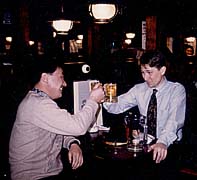Crime isn't yet what I'd call a large problem in Korea, though it's a growing one. In 2015, Seoul ranked
number 424 out of 446 cities (safer than 95% of them) in
Numbeo's ranking
of cities by crime index. In 2017, Seoul was number 338 out of 378 cities. That meant they were still safer
than 89% of the listed cities -- not a huge change, but not in the right direction either. Over that same
period, Seoul's Numbeo safety index fell from 81.8 to 76.2.
In the early 2000s, Korea's murder rate was one-fourth the USA's. Today it's just under half. So you're still
less likely to get killed in Korea than in the US, no doubt in part because it's much tougher to buy a gun there.
Again, though, the trend isn't what anybody would prefer.
When we were in Seoul in 2004, I did a double-take as we walked past a motorbike parked on the sidewalk.
(Yes, they do that here.) The rider had left his wallet on the seat. He wasn't anywhere in sight. I
figured it would be gone in minutes. We walked by again about 45 minutes later. Bike and wallet were
still there. Would that still happen in Seoul today? Hard to say, but I'm pretty sure it wouldn't happen in
New York or Philadelphia, then or now.
Even when Margaret was teaching, petty crimes and what you might
call "kid crimes" seemed to be on the increase. I read of teachers having bicycles stolen.
Margaret almost lost her wallet to some kid who lifted it from her tote bag when she wasn't looking -- though he
gave it back when he was confronted, claiming it was a joke. We also had an umbrella taken from beside the door
of a cafe where we'd left it to drip -- a little thing, but disappointing.
All that said, Korean cities are still safer to walk, day or night, than most comparable cities in other countries.
Partly this is because Korea hardly slows down at night, especially in Seoul! But I still recommend reasonable
caution.
Another matter to consider: some critics say there's more assault and rape than the Korean government's statistics
show, because a lot of it goes unreported. Ask your Korean friends about this, and what you should do to be safe.
If you're fresh off the airplane, just act like you would in Europe. That is, don't be careless, but don't be paranoid
either.
Public drunkenness. Now that's another story. It's not illegal in Korea. But if you like to party, don't celebrate
this too much. Just wait until you step in a puddle of vomit or urine some early Saturday morning.
Drunken men of every nation behave unpredictably. I don't want to over-emphasize this, but there are
possible hazards for you here.

| | Drinking with the boss
|
I'd like to say, "just stay away from the bars." But drinking is a
big part
of social and professional life in Korea, especially for men. When somebody invites you to have a drink
with him, it's rude to say no. Chances are pretty good that you'll find yourself in a Korean bar at least once
during your stay there. You could be there with your fellow teachers, your students, even your boss.
My recommendation is to keep your wits about you. That is, stay sober. There's a sneaky little trick to this.
Korean tradition says "Never let your friend's glass be empty." This also means "Don't
fill it until it is empty." So just don't drain your glass.
Also, when you go out with other Westerners, take a few Korean friends along if you can. They'll be
better prepared to deal with possible dicey situations.
When it's time to go home, you have to deal with the potential for drunken driving. Sobriety checkpoints
and big penalties haven't stopped it in Korea. You might try to steer the group to a bar within walking
distance.
As this all suggests, Korea is probably not the best place for a recovering alcoholic.
Speaking of driving, Koreans are some of the world's most aggressive drivers. Social good over individual
good is baked into Korean culture, but you put a Korean in a car or truck or bus and he's a
completely different critter. He might as well be the only driver on the road.
The good news is that Korean road safety has improved. In 2002 the fatality rate was 5.5 per 10,000
vehicles. In 2014 it had fallen by more than half, to 2.7 per 10,000 vehicles. But it's still nearly
double the US's rate of 1.4 per 10,000, and four times Japan's 0.7 per 10,000.
The numbers tell one story, but here's what it was like for us.
Some of the other teachers' web sites talk about wild bus rides and insane taxi drivers. You might
think this happens all the time. Well, maybe we were just lucky, but we had very few that were like that.
I did have one taxi driver who took some gut-wrenching risks passing on a 2-lane road to the airport. I guess
he thought I was late for my flight. Several times, we saw bus drivers tailgate dangerously closely, then
swing out and cut off cars that were going too slow for their tastes. I also watched one bus driver talk on
his mobile phone most of the way from Seoul to Kangnung (Gangneung) -- about 3 hours! Fortunately, he was using
a headset. And both of us rode with some "civilian" drivers who drove too fast and, shall we say,
not very accurately.
But most of our taxi rides were no wilder than the ones we've had in Europe, for what that's worth. Most of the
long distance bus rides were fairly calm. So while driving lunacy does happen, it's not as bad as it's sometimes
made out to be. Wear your seat belt, and not just because Korean law requires it.
|
